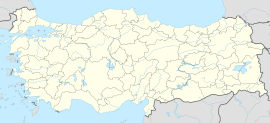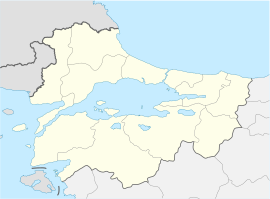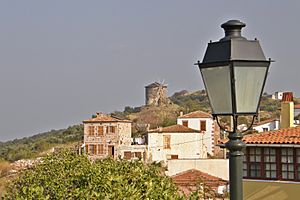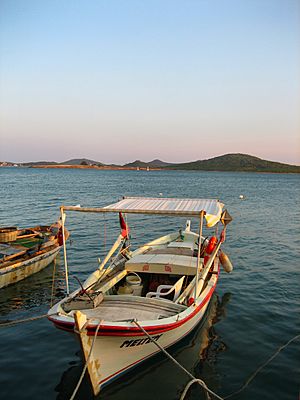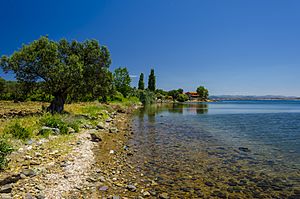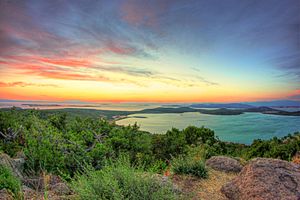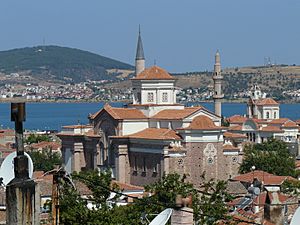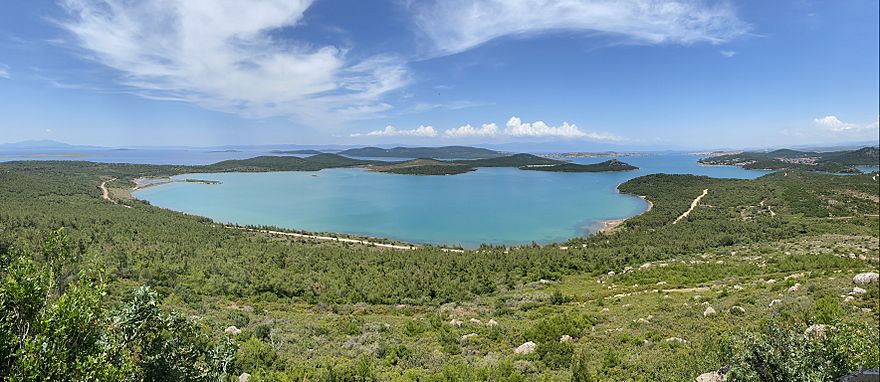Ayvalık facts for kids
Quick facts for kids
Ayvalık
|
||
|---|---|---|
|
Settlement
|
||

View of Ayvalık town centre
|
||
|
||

Map showing Ayvalık District in Balıkesir Province
|
||
| Country | Turkey | |
| Province | Balıkesir | |
| Area | 305 km2 (118 sq mi) | |
| Population
(2022)
|
74,030 | |
| • Density | 242.7/km2 (628.6/sq mi) | |
| Time zone | TRT (UTC+3) | |
| Postal code |
10400
|
|
| Area code | 0266 | |
Ayvalık is a lovely seaside town in Turkey, located on the northwestern coast of the Aegean Sea. It's part of Balıkesir Province. The town center is connected to Cunda Island by a special road. Ayvalık is also surrounded by many small islands, called the Ayvalık Islands, and it faces the nearby Greek island of Lesbos.
Long ago, during the Ottoman Empire, Ayvalık was famous for making olive oil. You can still see the old factory chimneys around town. Today, olive oil is still made here, but in a smaller, more special way.
You can take daily ferries from Ayvalık to Mytilene on Lesbos Island in Greece. The closest airport is Balıkesir Koca Seyit Airport, which is near Edremit.
Contents
What's in a Name?
The town was once an ancient Greek port called Kydonies. Later, during the Ottoman era, its name changed to Ayvalık, which means 'Quince orchard'. Before 1923, most people living here were Greek. They used both the old name Kydonies and a Greek version of the new name, Aivali.
The Greeks called Cunda Island Moschonisia, meaning "The Perfumed Islands". But the Turks called it Alibey Island (Alibey Adası).
Where is Ayvalık?
Ayvalık is the southernmost part of Balıkesir province. It sits between the Edremit Gulf and Dikili Gulf in the Aegean Sea. The town center is on a flat area near the coast, with low hills to the east. These hills are covered with pine and olive trees.
To the west, Ayvalık is surrounded by the Ayvalık Islands, with Cunda Island being the biggest. To the south, there's a narrow piece of land called the Hakkıbey Peninsula.
South of Ayvalık, you'll find Altınova and Küçükköy/Sarımsaklı, which have long, beautiful beaches. To the north are towns like Gömeç, Burhaniye, and Edremit. The Dikili district of İzmir Province is to Ayvalık's south. East of Ayvalık is Bergama, where you can see the ruins of ancient Pergamon.
The Greek island of Lesbos is to the west of Ayvalık. You can travel between them by ferry.
Ayvalık's Climate
Ayvalık has a hot-summer Mediterranean climate. This means it has mild, rainy winters and hot, dry summers. It's a great place for sunny holidays!
A Look Back in Time
Ancient Times
Archaeological studies show that people lived in Ayvalık and the areas around it a very long time ago. Some settlements near Altınova date back to the Bronze and Iron Ages. Places like Kortukaya and Yeni Yeldeğirmeni were important for understanding how people lived and traded between the coast and inland areas.
Traces of an old hill fort were found on Çıplak Island (Chalkys). Pottery from the Late Bronze Age and Early Iron Age, linked to the Aeolians, was also discovered there.
Pordoselene, on the eastern side of Cunda Island, was another important ancient settlement. During the Byzantine period, attacks by pirates kept the island settlements from growing much. Only Cunda Island, being the largest and closest to the mainland, had more people living on it.
Early Turkish Rule
After the Byzantine period, the region came under the rule of the Anatolian beylik of Karasi in the 13th century. Later, it became part of the Ottoman Empire.
A Special Time for Ayvalık
In 1770, the Ottoman navy faced a big defeat. An Ayvalık priest kindly helped the surviving Ottoman sailors and their admiral, Cezayirli Gazi Hasan Pasha. When Hasan Pasha became a very important leader, he remembered this kindness. In 1773, he gave the Greek people of Ayvalık special freedom to govern themselves. This helped Ayvalık become a major cultural center for the Greek community for many years. Until 1922, Ayvalık was almost entirely a Greek settlement.
Changes and Conflicts
In 1821, during the Greek struggle for independence, there was fighting in Ayvalık. Some people hoped for rescue from Greek ships, leading to more conflict. After the fighting, the town faced difficult times. In 1891, most of the people living in Ayvalık were Greek.

World War I and After
Around 1920, Ayvalık had about 60,000 people. Its small port was used to export things like soap, olive oil, and animal hides. Ayvalık was known for having some of the best olive oil in the region.
During World War I, the olive oil industry suffered because many local Christian people, who were the main producers, had to leave. To help the industry, the Turkish government brought back some Greek families to restart olive oil production.

On May 29, 1919, the town was taken by the Greek Army. But on September 15, 1922, Turkish forces, led by Mustafa Kemal Atatürk, took it back. Some people managed to escape to Greece. However, many local men faced forced journeys into the interior of Anatolia. Among those affected were the Christian religious leaders, including Bishop Gregory Orologas, and the writer Elias Venezis, who later wrote about his experiences.
After the Turkish War of Independence, there was an agreement in 1923 to exchange populations between Greece and Turkey. This meant the Greek people and their properties in Ayvalık were exchanged for Muslim people from Greece and other former Ottoman lands. Most of the new residents came from Mytilene (Lesbos), Crete, and Macedonia. The Greeks from Ayvalık who survived settled in Lesbos and Aigaleo, Greece. Even recently, you could still hear Greek spoken in the streets. Many of the town's older mosques were once Greek Orthodox churches that were later used for a new purpose.
Ayvalık Today
Today, Ayvalık has about 80,000 people. This number grows a lot in the summer because many tourists visit. Ayvalık and its surrounding areas are famous for making high-quality olive oil, which is very important for the local people's income.
Ayvalık and the many small islands around its bay are popular places for holidays. The biggest and most important island is Cunda Island (also called Alibey Island). It's connected to Lale Island, and then to the mainland, by a bridge and a special road built in the late 1960s. This was the first bridge in Turkey to connect lands separated by a strait. Both Ayvalık and Cunda Island are well-known for their delicious seafood restaurants along the seashore.
Ayvalık also has two of the longest sandy beaches in Turkey: Sarımsaklı and Altınova beaches. They stretch for almost 30 kilometers (19 miles) to the south. In recent years, Ayvalık has also become a popular spot for scuba divers.
The Ayvalık International Music Academy (AIMA) started in 1998. Students there can take special classes for violin, viola, and cello.
Harvard University from the USA and Turkey's Koç University hold a special summer school on Cunda Island each year. It focuses on Ottoman and Turkish studies.
Ayvalık is also a member of the European Association of Historic Towns and Regions (EAHTR), which is based in Norwich.
Neighborhoods of Ayvalık
Ayvalık District has 34 different neighborhoods:
- 150 Evler
- Akçapınar
- Ali Çetin Kaya
- Altınova
- Bağyüzü
- Beşiktepe
- Bulutçeşme
- Çakmak
- Çamoba
- Fethiye
- Fevzipaşa-Vehbibey
- Gazi Kemal Paşa
- Hacıveliler
- Hamdibey
- Hayrettinpaşa
- İsmetpaşa
- Karaayıt
- Kazım Karabekir
- Kırcalar
- Küçükköy
- Mithatpaşa
- Murateli
- Mutlu
- Namıkkemal
- Odaburnu
- Sahilkent
- Sakarya
- Sefaçamlık
- Tıfıllar
- Türközü
- Üçkabaağaç
- Yeniköy
- Yenimahalle
- Zekibey
Fun Things to See and Do
In Ayvalık and Cunda
Both Ayvalık and Cunda have many beautiful old stone houses. These were built by the Greek population who lived there long ago. You can also see several large and impressive Greek Orthodox churches. Some of these churches have been changed into mosques. For example, the Ayios Yannis Kilise became the Saatlı Cami (Clock Mosque), and Ayios Yorgis became the Çınarlı Cami (Plant Tree Mosque). The Taksiyarhis Kilise (Church of the Archangels) is now a museum.
On Cunda Island, there's another wonderful Taksiyarhis Kilise (Church of the Archangels) that was once very important to the local community.
Cunda Island has many meyhanes (traditional taverns) that feel very Greek. There's also the Taş Kahve (Stone Teahouse) with a great view of the harbor. In the back streets of Ayvalık, the Şeytanın Kahvesi (Devil's Teahouse) also has a Greek feel.
Both Ayvalık and Cunda Island have charming fishing harbors filled with colorful boats. Some restaurants sell papalina (whitebait), which is a special local dish.
Exploring Around Ayvalık
You can easily drive to the ruins of three important ancient cities from Ayvalık. Assos and Troy are to the north, and Pergamon (now called Bergama) is to the east. Mount Ida (Kaz Dağı in Turkish), which is famous in ancient Greek mythology and folk tales, is also near Ayvalık to the north. You can see it from many places in and around the town.
The Gulf of Edremit and the coastal towns of Dikili and Foça are also close enough for day trips.
Olive Oil Capital
Ayvalık has been growing olives for thousands of years! Today, there are over 2.5 million olive trees in the region, covering about 41% of the land. Hundreds of these trees are more than 500 years old.
Making olive oil for sale started in the 1950s and became very important in the 1960s. Now, Ayvalık is the second-largest producer of olives in Turkey.
The Ayvalık olive is one of the main types grown here. About 80% of the olives are used to make oil, and 20% are prepared as table olives to eat.
Famous People from Ayvalık
- Photis Kontoglou, a Greek writer, painter, and artist who created religious icons.
- Elias Venezis, a Greek author.
- Gregory (Orologas) of Kydonies, a religious leader who helped many Greek people leave for Greece. He was later executed by Turkish authorities.
- Stratos Pagioumtzis, a Greek singer of rebetiko music.
- Konstantinos Tombras, who ran the first printing press in Ayvalık and the first in Greece.
- Georgios Tombras, a Greek soldier.
- Marco Misciagna, an Italian violist, was given honorary citizenship of Ayvalık.
- Efstratios Pissas, a Greek revolutionary and later a general.
See also
 In Spanish: Ayvalık para niños
In Spanish: Ayvalık para niños


